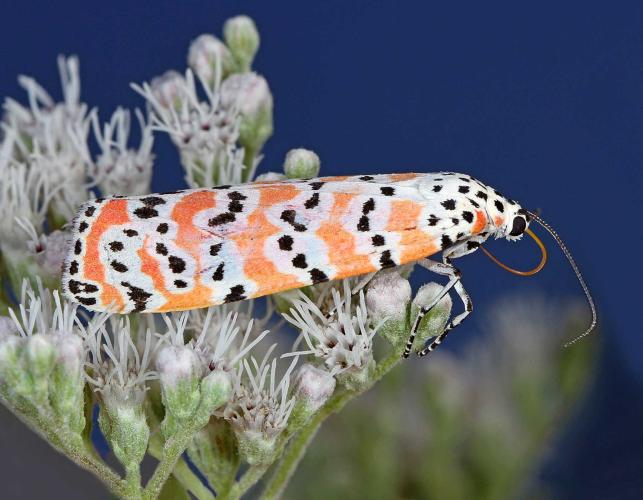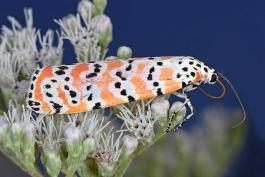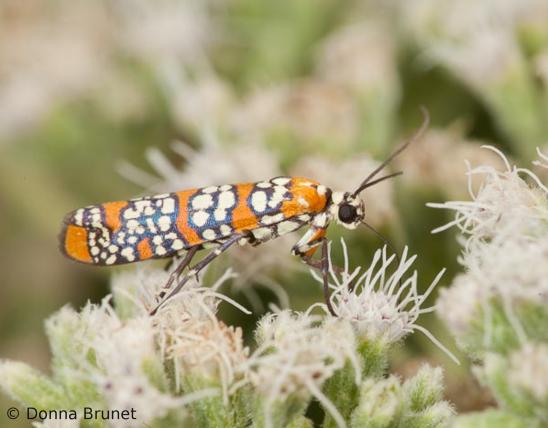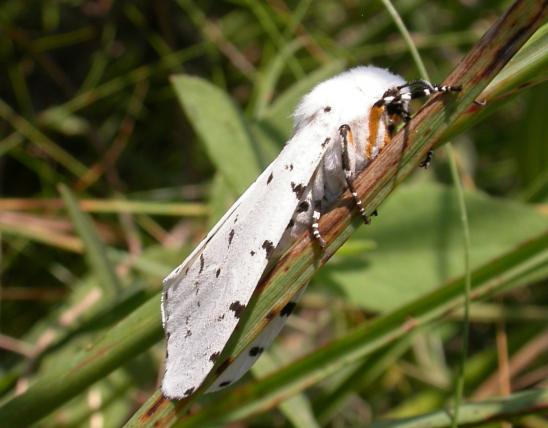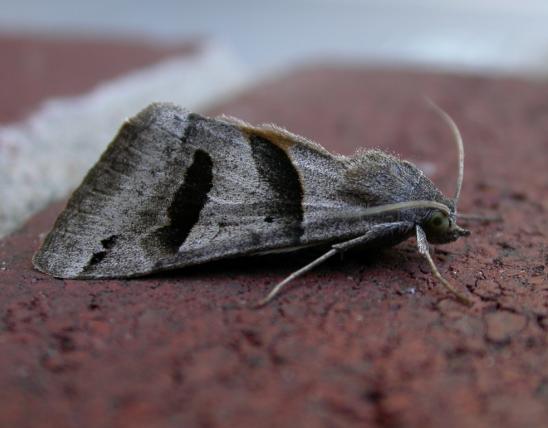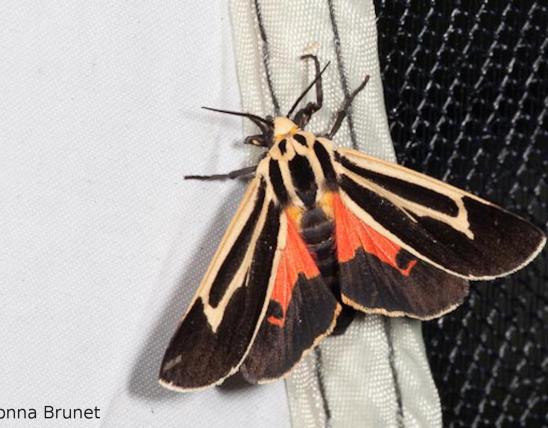
The ornate bella moth, one of our most colorful moths, has several common names, including calico moth and rattlebox moth. Its memorable colors warn predators that these moths contain toxic substances. As caterpillars, these moths accumulate toxins in their bodies as they feed on toxic rattlebox plants.
Color varies genetically from individual to individual, and the predominant coloration in a population varies by region. The forewing uppersides generally are orange, pink, yellow, or red (sometimes white) with about 6 irregular bands of black dots outlined with white. The hindwing uppersides are usually pink, with an uneven and variable black outer margin. In flight, the overall impression is of a pink-fluttering moth.
The sexes are very similarly colored and patterned.
Although the caterpillars of most species in the tiger moth group are fuzzy “woolly bears,” the caterpillars of the bella moth are not covered with furry bristles. Bella moth caterpillars have a yellowish-rust body with the inflated, middle portion of each segment colored with an irregular black band; the creases between segments are lighter with some white markings; tubercles are black, most with only a single, long, barbed hair (these hairs are longest at the front and rear of the body); the head is orange-brown.
Learn more about the tiger and lichen moth subfamily (the arctiids) on their group page.
Similar species: Missouri has about 60 species in the tiger and lichen moth subfamily (Arctiinae), many of which have bright orange, yellow, red, or pink–plus–black colorations. None, however, have the distinct pattern of the bella moth.
In Missouri, the bella moth is most likely to be confused with an unrelated species, the ailanthus webworm moth, which feeds on nonnative, invasive ailanthus trees (tree-of-heaven) in the caterpillar stage. It is more commonly encountered than the bella moth. The forewings of the ailanthus webworm moth are orange with white spots outlined in black (looking a bit like tiny flower patterns), but these moths appear thinner as they curl their wings lengthwise along the body, to form a tube with parallel sides. The hindwings are clear with dark margins. Also, it is a smaller moth, with a wingspan of only ½–1¼ inches.
Wingspan: 1½ to 1¾ inches.
Statewide. This species ranges from the eastern and midwestern United States south into Central America.
Habitat and Conservation
This colorful moth is usually uncommon in Missouri, but it sometimes occurs in fair numbers in areas where the food plants, rattleboxes (Crotalaria spp.), are abundant, typically in grasslands and woodland borders.
The adult moths fly during the day but are also frequently found at lights. They visit flowers, especially goldenrods, in mid- to late summer and fall.
Food
As with many other moths, the fortunes and life cycles of this species are closely tied with their particular larval food plants.
The primary caterpillar food plants are rattleboxes (Crotalaria spp.), which are in the bean/pea family. They contain toxic alkaloids that the caterpillars consume and store in their bodies. The fruits are inflated legumes (technically bean pods) about 1 inch long; at maturity when the pods turn dark, the bean seeds inside the pod tend to break free from the inside of the pod (before the pod splits open), so if you shake it, the whole pod is like a little rattle (hence the name).
Bella moth caterpillars, upon hatching, initially eat leaves, but after a few molts, they try to enter the developing seedpods and eat the seeds, which have a higher proportion of toxic alkaloids than the leaves. If all the seedpods are already claimed by other larvae, any latecomer larvae must make do eating just the leaves.
In Missouri, the most common and widespread species of rattlebox is Crotalaria sagittalis. A small, hairy plant, it grows scattered over most of the state and bears yellow pea-shaped flowers May–September.
Missouri’s other species of rattlebox is showy rattlebox, Crotalaria spectabilis. It is a native of Asia and was introduced for use as an agricultural cover crop (though not as a forage crop, since rattlebox plants are toxic). It has escaped and formed naturalized populations. These populations occur in some parts of the Bootheel and in a few counties bordering the Missouri River. Habitats include fallow fields, roadsides, and open, disturbed areas.
Bella moth caterpillars have been recorded on other plants, too, especially other members of the bean/pea family, including bush clovers (Lespedeza spp.). Missouri has about 12 species of lespedezas, including round-headed bush clover; hairy, prairie, tall, Thunberg’s, and slender lespedezas; and the nonnative, invasive sericea lespedeza.
Bella moth caterpillars have also been reported eating the foliage of elms (Ulmus) and of members of genus Prunus, a group that includes plums, cherries, peaches, apricots, and almonds. They have also been known to eat members of genus Myrica, which includes sweet gale, bog-myrtle, and bayberry (bayberry, native to states farther east, is cultivated in Missouri as a pleasant-smelling landscaping shrub).
Status
Uncommon resident with localized, larger populations in areas with abundant food plants.
In the past, two species of bella/rattlebox moths were recognized in North America, but now they are considered only one species — it simply has different color variations based on region. Thus Utetheisa bella, which used to be the name for our species, has been renamed and merged with U. ornatrix. This is the only species in the genus that occurs in North America north of Mexico.
Life Cycle
Adults fly in Missouri from July until late November. Multiple broods are possible. In Florida and other southern states, they breed year-round. Bella moths may survive for three to four weeks in the winged, adult stage.
The reproductive biology of bella moths is fascinating and has been studied closely. Females mate with a number of males, selecting those mates based, in part, on how strongly the males smell of a particular pheromone (mating scent). That pheromone is stronger when the male has greater amounts of toxic alkaloids stored in this body. During mating, the male provides a sperm packet (spermatophore) to the female that contains nutrients (which she digests) and a good quantity of toxic alkaloids, which contributes to the protection of the female; some of the alkaloids are eventually transferred to the offspring. A male can lose up to 11 percent of his body mass during mating.
After mating with three or four males, the female’s body selects which spermatophore will fertilize her eggs. Muscles in her abdomen channel the sperm based on the intensity of the “winning” male’s courtship pheromones.
The breeding biology and behavior of bella moths has many more remarkable aspects, including
- Females typically emit mate-attracting pheromones as a “chorus” and compete for the largest males with the strongest scents. Female-female competition for males is unusual in the animal kingdom (usually, males compete for females). Usually, the high physical costs to the female to produce and deposit eggs causes them to be competed for by males. But in the case of the bella moth, the reversal is driven by the large investment males must make upon each mating attempt.
- Mating with multiple males allows the female to acquire more nutrients in the form of spermatophores.
- The alkaloid content of these insects is important not only for protection from predators (during all life stages) but also for mating selection and success.
Human Connections
The ornate bella moth is undoubtedly one of the most attractive moths found in North America. Butterfly and moth enthusiasts often see pictures of bella moths in field guides and social media posts and add them to their list of “must-sees.” Many people plant native plants in order to increase the diversity of moths, butterflies, bees, and other insects in their neighborhood. In addition to increasing the variety of pollinators in an area, native plant gardening also provides a buffet of insects for nesting birds and other predators to eat. The ornate bella moth, however, is not eaten by many insectivores.
Two of the common names for this moth (bella and ornate) arose because those are translations of the two scientific names that used to be applied to this species: Utetheisa bella and U. ornatrix.
Ecosystem Connections
As with several other members of the tiger moth subfamily, the bella moth is brightly colored as a warning to its potential enemies: “bright orange–plus–black–equals–yuk!” In this case, the caterpillars, as they eat poisonous rattlebox plants, consume and store the plants’ toxic alkaloid chemicals in their bodies. The toxins are retained even after the caterpillars transform into adults. People have observed spiders removing living bella moths from their webs. When threatened, the adults can secrete a toxic foam from their head; bats and birds quickly reject bella moths as prey. More remarkably, the male’s sperm packages (spermatophores) are rich in the toxic alkaloids, and the female’s eggs also contain the toxin, so that even the eggs are protected by the noxious chemicals. Thus ants and other potential egg-eaters are turned off by the toxin.
In states such as Florida, where the introduced showy rattlebox (Crotalaria spectabilis) has proven to be invasive, the bella moth is apparently helping to control its spread. The toxicity of rattlebox plants renders them unpalatable to most other herbivores, so land managers are glad the bella moth has been able to eat the nonnative species. Florida has 10 species of nonnative rattleboxes. The bella moth seems to be expanding its numbers and range in areas where the nonnative rattleboxes are spreading.
Loggerhead shrikes apparently can eat bella moths with little problem. Also, presumably, bella moths that develop on some of the alternate host plants (such as bush clovers, elms, or plums, which lack toxic alkaloids) might be palatable to predators. Their bright orange-and-black coloration, however — shared by many kinds of toxic or bad-tasting insects — no doubt protects them anyway.
